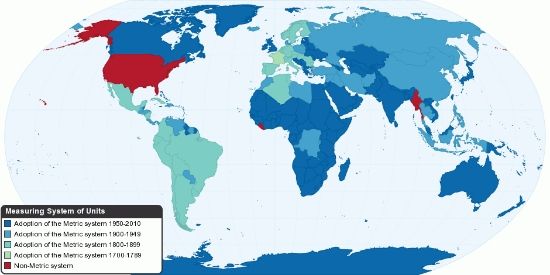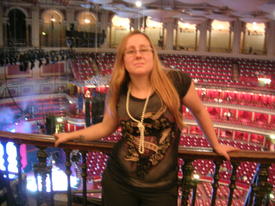How much water is 8 cups?
Options
Replies
-
The metric system is the tool of the devil! My car gets 40 rods to the hogshead and that's the way I likes it.0
-
OP, this was just a misunderstanding. Your written English is excellent, so the American posters just assumed you were one of their own.
People here are generally helpful, but they do like to poke fun a bit. No one meant any harm.0 -
@ Stormieweather:
Thank you very much. I feel quite ridiculed for asking a question, and I honestly don't think that's what this site is supposed to transmit to its users.
Thanks for asking, I wasn't sure either ) 0
) 0 -
Oh lookie... They use it in Mexico too! http://allrecipes.com.mx/receta/216/pastel-de-tres-leches-ii.aspx
It's a North America thing I guess...
A bunch of people around the world have to use it due to American influence from the internet, the website is American based and translated.
I have never seen in my life a measuring cup set with oz on it ( Sold outside the US I mean) . It's not just Americans, has nothing to do with the Imperial system. It actually even makes more sense in the metric one a cup is 250 ml! It's a standard normal measurement.
I'm way too bored to when I argue with random internet folks about something this silly.
Actually an American cup is 236.59 ml. I know I might just have ruined your "makes sense" argument, but look at the bright side you learned a random new fact today.
And helping people who ask a legitimate question is never silly, or helping people who simply just didn't know any better.0 -
Oh lookie... They use it in Mexico too! http://allrecipes.com.mx/receta/216/pastel-de-tres-leches-ii.aspx
It's a North America thing I guess...
Well... I could disagree with you on this one: "taza" in Spanish is like "taça" in Portuguese... it can mean a whole bunch of things. It can mean bowl, wine glass... the rule in cooking is that you use the same measuring "instrument" in that recipe (if you use an empty yogurt cup to measure one thing, then you should use it as your measure).
A cup is a cup. A measuring cup is a measuring cup. And both come in different shapes and sizes.
And I SWEAR I never thought of using a measuring cup as a drinking glass! LOL!!!0 -
And for the record, we use Cups as a unit of measure in Canada as well and we do not use to imperial system.
If you notice they have ML measurements written on them too.
I never understood why they are called cups, more like spoons to me
We have them in the UK, it's just most recipes don't ask for them or not ones I use anyways.0 -
And for the record, we use Cups as a unit of measure in Canada as well and we do not use to imperial system.
If you notice they have ML measurements written on them too.
I never understood why they are called cups, more like spoons to me
We have them in the UK, it's just most recipes don't ask for them or not ones I use anyways.
It's probably the way recipes are written. I'm French Canadian and when I get recipes from France they make no sense to me because they use European measurements. I'm guessing it's similar between North American recipes and UK ones.
( and we also have measuring spoons, those are the small ones; tablespoon,teaspoon..)0 -
@ slkehl:
Actually, not that confusing. Do you only have 1 kind of cup in the US? In my cupboard I have expresso cups, coffee cups, tea cups, milk cups, wine glasses, water glasses, juice glasses, etc etc etc (I could go on, but I don't see the point). See why it is a legit question now? A pound is a measurement, a cup is an object which can vary in size.
Unless, perhaps, you are from the UK. Then, of course a pound is both a unit of CURRENCY as well as a measurement.
So a pound can equal any of the following:
a) 100 pence
b) 1 quid
c) 0.0714286 stone
d) 0.453592 kg
Now I wonder if anyone can answer how many pounds does 1 pound sterling weigh?0 -
And helping people who ask a legitimate question is never silly, or helping people who simply just didn't know any better.
I actually meant arguing about the fact that they are also used pretty much everywhere in North America. It was a legitimate question for the OP to ask.0 -
The funny thing about this topic is, how Americans still believe the world revolve around them. The units of measure this country uses are only used by Liberia and Burma. Some other sources like the National Institute of Standards and Technology (NIST) say the system in the US no one else uses it. Every other country in the world uses metric system. And yet, some Americans make fun of those who don't know this ridiculous system.

Larger version of the image above in the link below
http://tinyurl.com/a6kf5kj
The United States and the Metric System (PDF file by NIST)
http://www.nist.gov/pml/wmd/metric/upload/1136a.pdf0 -
The funny thing about this topic is, how Americans still believe the world revolve around them. The units of measure this country uses are only used by Liberia and Burma. Some other sources like the National Institute of Standards and Technology (NIST) say the system in the US no one else uses it. Every other country in the world uses metric system. And yet, some Americans make fun of those who don't know this ridiculous system.

Larger version of the image above in the link below
http://tinyurl.com/a6kf5kj
Exactly what I was going to say.
A cup is confusing to anyone that uses a different system. Guess what? A lot of people in the US have to use the metric for their profession. So lets just say a bunch of Americans think that the cup is standard for everyone, it is not.
Metric System use in green0 -
The funny thing about this topic is, how Americans still believe the world revolve around them. The units of measure this country uses are only used by Liberia and Burma. Some other sources like the National Institute of Standards and Technology (NIST) say the system in the US no one else uses it. Every other country in the world uses metric system. And yet, some Americans make fun of those who don't know this ridiculous system.

Larger version of the image above in the link below
http://tinyurl.com/a6kf5kj
The United States and the Metric System (PDF file by NIST)
http://www.nist.gov/pml/wmd/metric/upload/1136a.pdf
Q: Burma? Why did you say Burma?
A: I panicked.
Sorry couldn't resist the Monty Python quote.
But, yes, as a nation we here in the States are pitifully US-Centric.0 -
The OP had a legitimate question that said....
Alright just because I'm getting annoyed at pretty much everyone ( Because I have nothing else to do at work) For the last time. A Cup ( as in a unit of measure) Is NOT an American thing, It's used in a bunch of countries. It's NOT an Imperial measurement.
Here we go ( Copy pasting from Wikipedia so no one has to Google it)
The cup is a customary unit of measurement for volume, used in cooking to measure liquids (fluid measurement) and bulk foods such as granulated sugar (dry measurement). Actual cups used in a household in any country may differ from the cup size used for recipes; standard measuring cups, often calibrated in fluid measure and weights of usual dry ingredients as well as in cups, are available.
As a result of the fact that the imperial cup is actually out of use and the other definitions differ hardly (±3%), the U.S. measuring cups and metric measuring cups may be used as equal in practice.
No matter what size cup is used, the ingredients of a recipe measured with the same size cup will have their volumes in the same proportion to one another. The relative amounts to ingredients measured differently (by weight, or by different measures of volume such as teaspoons, etc.) may be affected by the definitions used.
In Commonwealth of nations (such as Canada, Australia, New Zealand, Indian Subcontinent, South Africa, ...), Latin America and Lebanon one cup is commonly defined as 250 millilitres[citation needed].
1 cup = 250 millilitres
= 162⁄3 international tablespoons (15 mL each)
= 12.5 Australian tablespoons
≈ 8.80 imperial fluid ounces
≈ 8.45 U.S. customary fluid ounces
A "coffee cup" is 1.5 dl, and is occasionally used in recipes.
United States customary cup is defined as half a U.S. pint.
1 U.S. customary cup = 1⁄16 U.S. customary gallon
= 1⁄4 U.S. customary quart
= 1⁄2 U.S. customary pint
= 8 U.S. customary fluid ounces
= 16 U.S. customary tablespoons[nb 1]
≡ 236.5882365 millilitres[nb 2]
≈ 152⁄3 international tablespoons
≈ 11.75 Australian tablespoons
≈ 0.833 imperial cups
≈ 8.33 imperial fluid ounces
In Europe, cooking recipes normally state any liquid volume larger than a few tablespoons in millilitres, the scale found on most measuring cups worldwide. Non-liquid ingredients are normally weighed in grams instead, using a kitchen scale, rather than measured in cups. Most recipes in Europe use the millilitre or decilitre (1 dL = 100 mL) as a measure of volume. For example, where an American customary recipe might specify "1 cup of sugar and 2 cups of milk", a European recipe might specify "200 g sugar and 500 mL of milk" (or 0.5 litre or 5 decilitres).[citation needed] Conversion between the two measures must take into account the density of the ingredients. Many European measuring cups have additional scales for common bulk ingredients like sugar, flour, or rice to make the process easier.0 -
It's cute when people talk like all 350,000,000 Americans are the same.0
-
It's cute when people talk like all 350,000,000 Americans are the same.
LOL
It's also cute when people talk like all 792,200,000 "Europeans" (whatever that means...) are the same. Europe is not a country, to those of you who think it is. :P0 -
The OP had a legitimate question that said....
Alright just because I'm getting annoyed at pretty much everyone ( Because I have nothing else to do at work) For the last time. A Cup ( as in a unit of measure) Is NOT an American thing, It's used in a bunch of countries. It's NOT an Imperial measurement.
Here we go ( Copy pasting from Wikipedia so no one has to Google it)
The cup is a customary unit of measurement for volume, used in cooking to measure liquids (fluid measurement) and bulk foods such as granulated sugar (dry measurement). Actual cups used in a household in any country may differ from the cup size used for recipes; standard measuring cups, often calibrated in fluid measure and weights of usual dry ingredients as well as in cups, are available.
As a result of the fact that the imperial cup is actually out of use and the other definitions differ hardly (±3%), the U.S. measuring cups and metric measuring cups may be used as equal in practice.
No matter what size cup is used, the ingredients of a recipe measured with the same size cup will have their volumes in the same proportion to one another. The relative amounts to ingredients measured differently (by weight, or by different measures of volume such as teaspoons, etc.) may be affected by the definitions used.
In Commonwealth of nations (such as Canada, Australia, New Zealand, Indian Subcontinent, South Africa, ...), Latin America and Lebanon one cup is commonly defined as 250 millilitres[citation needed].
1 cup = 250 millilitres
= 162⁄3 international tablespoons (15 mL each)
= 12.5 Australian tablespoons
≈ 8.80 imperial fluid ounces
≈ 8.45 U.S. customary fluid ounces
A "coffee cup" is 1.5 dl, and is occasionally used in recipes.
United States customary cup is defined as half a U.S. pint.
1 U.S. customary cup = 1⁄16 U.S. customary gallon
= 1⁄4 U.S. customary quart
= 1⁄2 U.S. customary pint
= 8 U.S. customary fluid ounces
= 16 U.S. customary tablespoons[nb 1]
≡ 236.5882365 millilitres[nb 2]
≈ 152⁄3 international tablespoons
≈ 11.75 Australian tablespoons
≈ 0.833 imperial cups
≈ 8.33 imperial fluid ounces
In Europe, cooking recipes normally state any liquid volume larger than a few tablespoons in millilitres, the scale found on most measuring cups worldwide. Non-liquid ingredients are normally weighed in grams instead, using a kitchen scale, rather than measured in cups. Most recipes in Europe use the millilitre or decilitre (1 dL = 100 mL) as a measure of volume. For example, where an American customary recipe might specify "1 cup of sugar and 2 cups of milk", a European recipe might specify "200 g sugar and 500 mL of milk" (or 0.5 litre or 5 decilitres).[citation needed] Conversion between the two measures must take into account the density of the ingredients. Many European measuring cups have additional scales for common bulk ingredients like sugar, flour, or rice to make the process easier.
Le sigh... at this point it's not really worth it trying to explain. But on the bright side ignorance is bliss they say.0
Categories
- All Categories
- 1.4M Health, Wellness and Goals
- 391.7K Introduce Yourself
- 43.5K Getting Started
- 259.7K Health and Weight Loss
- 175.6K Food and Nutrition
- 47.3K Recipes
- 232.3K Fitness and Exercise
- 395 Sleep, Mindfulness and Overall Wellness
- 6.4K Goal: Maintaining Weight
- 8.5K Goal: Gaining Weight and Body Building
- 152.7K Motivation and Support
- 7.8K Challenges
- 1.3K Debate Club
- 96.3K Chit-Chat
- 2.5K Fun and Games
- 3.3K MyFitnessPal Information
- 23 News and Announcements
- 957 Feature Suggestions and Ideas
- 2.3K MyFitnessPal Tech Support Questions










